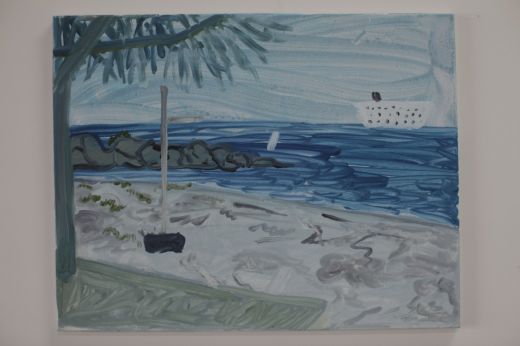Tyson Reeder: Beach Painting Club
Laura Randall

Tyson Reeder, Hobie Beach, 2013, Acrylic on Canvas, 22x28 inches.
Bas Fisher Invitational
Ongoing
The limitations of outdoor painting come to the fore in these works, forcing Reeder to adapt to a much speedier execution. In the past, Reeder’s paintings of figures prompted a link to the Fauvist palate, and while this relationship is apparent in many of the works on view, en plein air painting necessitates that the artist grapple with the merits of Impressionism. Reeder’s artistic practices lends itself to the lifestyle of an itinerate painter—he often works on a smaller scale and prefers to use acrylics making his work both portable and dry by the time he is finished. In the 28”x22” “South Point,”(2013) no doubt painted late in the day (probably around 6:00 p.m.), the artist was instantly reminded of how quickly the sun sets, evidenced by the progression of the sky from a smooth light gray to a darker, more rapid brushstroke along the top of the canvas. There is little time to focus on details—everything depends on light. The cargo ship in the middle ground of the picture is on the brink of resembling a massive blob of dark blue, ensuring us that it is not just the water, but Reeder’s penchant for flattening the picture plane, that is making the object float.
Throughout these works, there is a sense that Reeder approaches painting markedly different than working in the confines of the studio. The laid-back atmosphere outdoors permits a relaxed approach to painting, free of the pressures of the studio. At times, there is an inconsistency in style from one painting to the next. A sandy path through the dunes takes on a more post-Impressionist exploration of distinctive lines and bright afternoon colors, able to convey the haze of the heat of the day. A sunset spent on Virginia Key can transform into a Fauvist dance with vibrant blocks of orange and blue. The state of Florida and Reeder’s own eccentric reputation shine through in these works; it is of little surprise Reeder would brave the trip to Haulover Beach where one can find turn-of-the-century bathers in the flesh, enjoying a volleyball match. We can thank the Impressionists in this last painting, as it is Reeder’s emphasis on the moment (he has painted the volleyball mid air), and not on clarity and accuracy, that counts.










